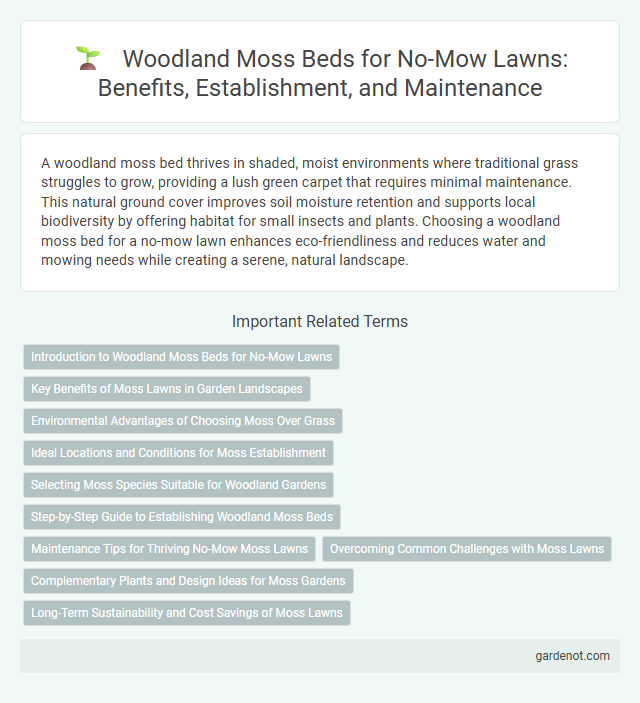A woodland moss bed thrives in shaded, moist environments where traditional grass struggles to grow, providing a lush green carpet that requires minimal maintenance. This natural ground cover improves soil moisture retention and supports local biodiversity by offering habitat for small insects and plants. Choosing a woodland moss bed for a no-mow lawn enhances eco-friendliness and reduces water and mowing needs while creating a serene, natural landscape.
Introduction to Woodland Moss Beds for No-Mow Lawns
Woodland moss beds thrive in shaded, moist environments, making them ideal for no-mow lawns seeking low-maintenance ground cover. These mosses enhance soil moisture retention, reduce erosion, and provide a lush, green carpet that requires no mowing or fertilization. Incorporating woodland moss beds supports sustainable landscaping by promoting biodiversity and reducing water usage in lawn care.
Key Benefits of Moss Lawns in Garden Landscapes
Woodland moss beds offer exceptional moisture retention and natural erosion control, making them ideal for shaded garden landscapes with low foot traffic. Moss lawns require minimal maintenance, eliminating the need for mowing, fertilizing, or watering, which reduces environmental impact and conserves resources. Their lush green texture enhances biodiversity by providing habitat for beneficial insects and improving soil health.
Environmental Advantages of Choosing Moss Over Grass
Woodland moss beds require significantly less water than traditional grass lawns, reducing overall water consumption and promoting sustainable landscaping. Moss absorbs carbon dioxide efficiently and supports biodiversity by providing habitat for small insects and microorganisms. Its low maintenance needs minimize the use of fertilizers and pesticides, decreasing chemical runoff and environmental pollution.
Ideal Locations and Conditions for Moss Establishment
Woodland moss beds thrive in shaded, moist environments with acidic, well-drained soil rich in organic matter. Ideal locations include forest floors, shaded garden areas, and sites with consistent humidity and minimal foot traffic. Establishing moss requires stable temperatures and protection from direct sunlight to maintain necessary moisture levels.
Selecting Moss Species Suitable for Woodland Gardens
Selecting moss species for a woodland moss bed requires focusing on shade-tolerant varieties like Hypnum, Dicranum, and Polytrichum that thrive in moist, acidic soils common in forested environments. These species create dense, lush ground covers that resist foot traffic and enhance biodiversity by providing habitat for microfauna. Ensuring compatibility with existing woodland flora and soil pH between 5.0 and 6.5 optimizes moss health and longevity in no-mow lawn designs.
Step-by-Step Guide to Establishing Woodland Moss Beds
Establishing a woodland moss bed begins by selecting a shaded, moist area with acidic soil to mimic natural forest conditions ideal for moss growth. Prepare the site by clearing debris and lightly raking the soil surface to create a smooth, compact seedbed for moss fragments or transplants. Maintain consistent moisture with misting and avoid foot traffic while the moss establishes, ensuring a thriving, low-maintenance no-mow lawn alternative.
Maintenance Tips for Thriving No-Mow Moss Lawns
Woodland moss beds require minimal maintenance, thriving best in shady, moist environments with acidic soil pH between 5.0 and 6.0. Regularly remove debris and avoid foot traffic to prevent compaction and damage, while occasional misting during extended dry periods supports hydration. Fertilization is unnecessary, but ensuring proper drainage and controlling competing plants helps maintain a lush, no-mow moss lawn.
Overcoming Common Challenges with Moss Lawns
Woodland moss beds thrive in shaded, moist environments where traditional grass struggles, making them an ideal low-maintenance, no-mow lawn alternative. Establishing a healthy moss lawn requires addressing common challenges such as soil acidity, moisture retention, and competition from invasive weeds by ensuring a consistently damp substrate with a pH between 5.0 and 6.0. Regularly removing debris and avoiding foot traffic preserves moss integrity, promoting dense, vibrant growth that enhances woodland landscape aesthetics while reducing water and maintenance needs.
Complementary Plants and Design Ideas for Moss Gardens
Woodland moss beds thrive when paired with complementary shade-loving plants such as ferns, hostas, and wildflowers that enhance texture and color contrast. Incorporating natural elements like rocks, driftwood, and winding stone pathways creates an organic, serene design that mimics forest floors. Using layered planting techniques with varying heights and leaf shapes maximizes visual interest while maintaining the low-maintenance benefits of a no-mow lawn alternative.
Long-Term Sustainability and Cost Savings of Moss Lawns
Woodland moss beds offer exceptional long-term sustainability by requiring minimal water, fertilizer, and mowing compared to traditional grass lawns, reducing environmental impact and maintenance efforts. Their dense, shade-tolerant growth enhances soil health and supports local biodiversity, creating a resilient ecosystem over time. Cost savings accumulate through decreased utility bills and maintenance costs, making moss lawns a financially efficient and eco-friendly alternative for homeowners.
Woodland moss bed Infographic

 gardenot.com
gardenot.com